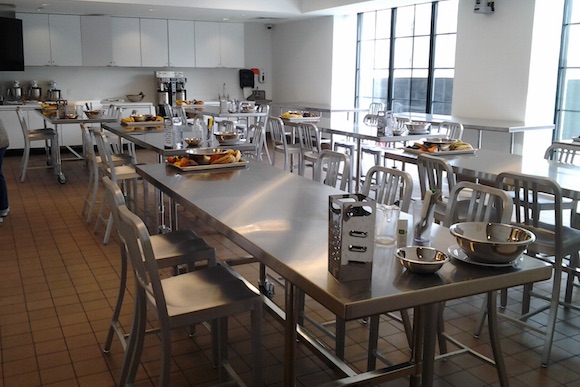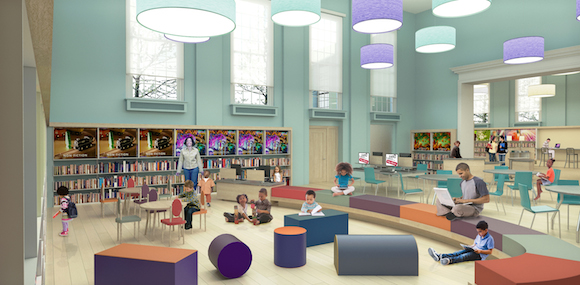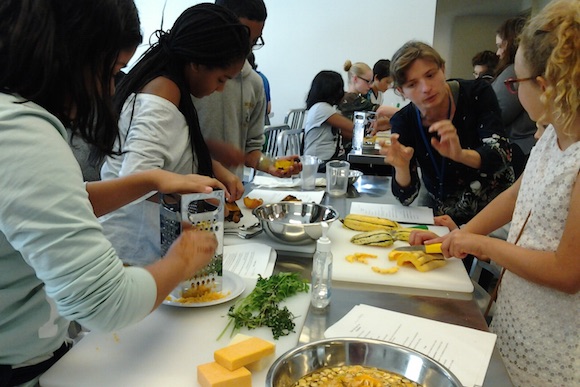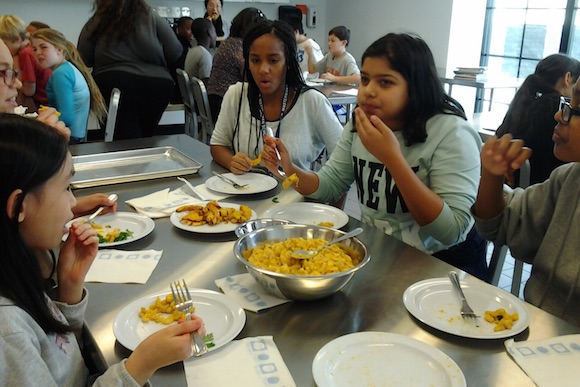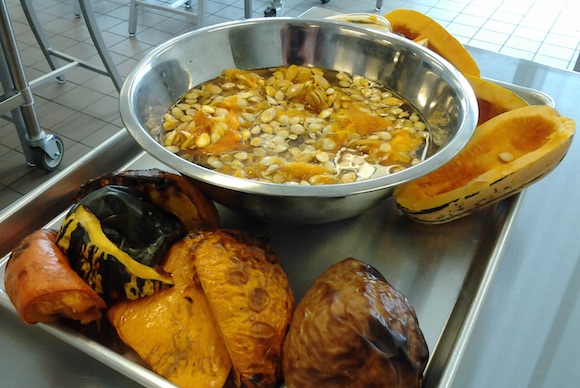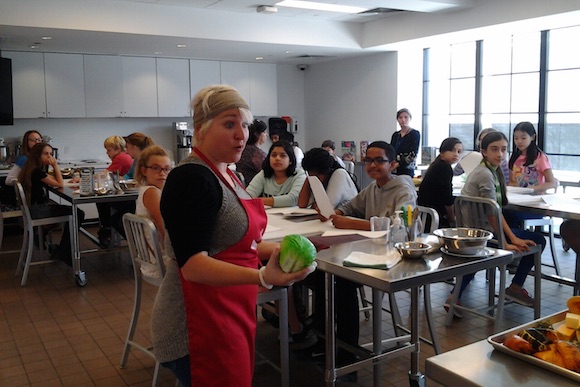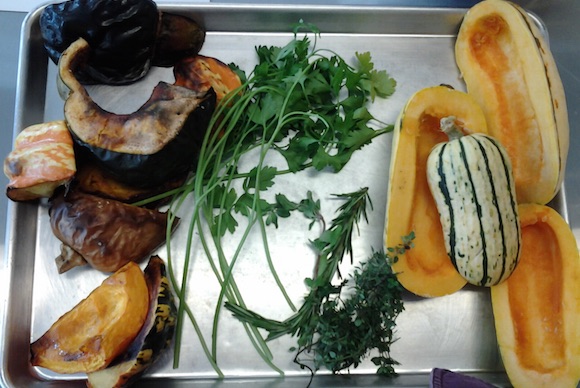If you think of the library and think of people at the circulation desk hissing “sshh!”, then you're not in the twenty-first century, and you're certainly not in Philadelphia. Forget “no food or drinks allowed” — this fall, activities in the main branch of the Free Library of Philadelphia included butchering a goat.
That's thanks to the Free Library's new Culinary Literacy Center (CLC), which Culinary Literacy Specialist Liz Fitzgerald says is the first of its kind in the country. The Center opened last June, and since then, has hosted a slew of events for all ages. It's one piece in a broader story of transformation at one of Philadelphia's most beloved institutions.
According to Fitzgerald (formerly the Wynnefield branch manager), CLC programming expands the definition of literacy beyond an appreciation for books and into the practice of real-life skills: reading and adapting recipes, the math of measurements and portion sizes, the chemistry of cooking and nutrition, and interacting with other cultures.
An “enthusiastic omnivore,” Fitzgerald has always enjoyed librarianship and public service, and has “real personal interest in food and nutrition” rooted in her own parents' tradition of family meals. Now, her daughter, nearing two years old, is developing sophisticated tastes for a toddler: “She eats Swiss chard like it's her job,” insists Fitzgerald.
The aforementioned Whole Goat Butchering workshop was presented in November with help from Kensington Quarters, the brand new Fishtown restaurant and butcher shop. No, the pastured goat wasn't killed onsite — that might be too much for even the most adventurous library patrons — but a demonstration from master butcher Brian Mayer taught attendees how to utilize the whole animal, appreciating its nourishing versatility and minimizing waste.
Held on the fourth-floor — in a spacious area that includes a classroom full of tables and a demonstration kitchen — other programs have offered Philadelphians instruction in various ethnic cuisines, SNAP nutrition tips, vegetarian cooking and more.
The kitchen (sponsored by Cancer Treatment Centers of America) became possible through a wide range of funding and partnerships, including support from the Garces and Vetri Foundations, Careers through the Culinary Arts Program, Drexel University, and the Mayor's Office of Sustainability.
In October, the Culinary Literacy Center invited Flying Kite to visit the culmination of a partnership with the Julia R. Masterman School: the Library provided copies of the Young Readers Edition of Michael Pollan's The Omnivore's Dilemma to a sixth-grade class as part of its new Nourishing Literacy Program. After exploring the book in the classroom, 33 students trooped to the Library kitchen for a discussion and cooking class with Fitzgerald, librarian Suzanna Urminska and Nourishing Literacy partner Shayna Marmar, “vegetable enthusiast” and owner of Honeypie Cooking.
Roasted squash seeds, Delicata squash chips and Marmar's own squash mac and cheese recipe were on the agenda, and Marmar wasn't fazed by over 30 kids set loose to mash, cut and grate.
“I work with children as young as two,” she says of her New York and Philly-based cooking, consulting and recipe business.
“Did you like the book?” Marmar asks in her welcome to the kids, after they flood in and take over the carefully prepped tables in groups of five or six. She received a ringing chorus of “Yes!”
They are going to learn how “you can make junk food-style food with ingredients that are really healthy for you,” Marmar explains.
Even if some kids didn't like the squash mac and cheese, this was a chance to practice sensitivity to others' tastes: “How do we tell the truth about food” and be respectful?, she inquires.
Nobody would be forced to try anything they didn't want to, but Marmar insists that everyone “talk with respect about that food.”
After a knife- and grater-safety demo, teacher Paula Conzelman and chaperoning parents Nadia Archer and Ann Ng pitch in for a brief but deafening tween bonanza of chopping and mixing.
At one table, Brandon, Noor, Saniah, Anaya and Chenjing discuss Pollan's book.
“I like how honest he was about the food and how he applied all that to our lives,” say Brandon.
Saniah was shocked to learn just how much corn is hiding in our food, and Anaya picked up a new habit of “eating junk food only once in awhile.”
When it was time to taste their creations, the table followed Marmar's suggestion — albeit by plating one tiny spoonful each. Noor was quick to explain that they didn't want to waste food if it turned out they didn't like it. But the taste quickly won them over for bigger scoops. Chenjing would definitely make it at home.
“I'm so glad you tried it, and now you're getting all this vitamin C!” Marmar cries as she swoops by.
Meanwhile, Urminska passed around a plate of specialty local cheeses. For a table of rowdy boys, this occasioned much pantomimed heaving and sweatshirts pulled up over noses.
Few are cheese connoisseurs at age twelve.
“The cheese is…the opposite of delicious,” Balansama explains as politely as he could.
The Culinary Literacy Center is only one side of a much grander evolution. The Library is putting increased emphasis on its interdisciplinary programs, and shifting its identity from solely a reading and research center to one as a community resource for everything from nutrition to job coaching. With the ability to borrow digital and audio books online already in place, they need to create new reasons for Philadelphians to visit their branches. In 2013, Library branches hosted over six million visitors and handled more than three million reference questions.
Last September, the Free Library announced its largest private gift ever: a $25 million grant from the William Penn Foundation. With the help of these funds and other partners, including the City of Philadelphia, the Library is launching its Building Inspiration: 21st Century Libraries Initiative.
“The William Penn Foundation, in making that large a grant to us, really thought that we were on to something,” explains Neighborhood Library Services Division chief Joe Benford. “They were willing to help fund the construction piece as long as we paid a lot of attention to the educational piece.”
The Building Inspiration project has three main pieces: continuing to renovate and expand the Parkway building, strengthening community partnerships (especially with Philly public schools; they often lack their own libraries due to budget cuts), and revitalizing branch locations across the city.
Five branches are now in the early design phases of total makeovers: the Lillian Marrero and Logan Libraries in the northern part of the city, Mt. Airy's Lovett Memorial Library, the South Philadelphia Library, and the Tacony Library in the far northeast.
Benson explains that the new South Philadelphia Library will not be funded by the William Penn Grant, but “is a very exciting opportunity for us.” It's a groundbreaking partnership with the Children's Hospital of Philadelphia: The new facility will combine a library, a health center (for things like yoga classes) and a new primary care office.
The other libraries, whose development will be supported by the William Penn grant and ongoing fundraising, will each have a different focus.
The Lillian Marrero branch will make early childhood literacy and “services for new Americans” a priority, while the Logan branch will foster literacy for the whole family. The Mt. Airy branch will get a new community center for all ages, while the Tacony branch will aid Torresdale Avenue's progress as a commercial corridor by focusing on resources for job seekers, small businesses and entrepreneurs.
According to Benson, every branch will be different, but they'll have common elements. These include a continued tradition of quiet spaces for reading and custom-designed rollaway furniture to ensure comfortable yet versatile public spaces.
The William Penn grant will also help with basic access: Due to the age of many of the branch buildings, as many as 14 of Philly's libraries aren't ADA compliant. All the new locations — as “prototypes” for remodels eventually planned at every branch — will be accessible to everyone.
As Masterman parent Nadia Archer put it, the visiting kids “can't believe they actually have a cooking place in the library.” As e-readers multiply, Philadelphia libraries will have to keep up by offering hands-on education and engaging activities as diverse as the books they've always had on the shelves.
ALAINA MABASO is a Philadelphia-based freelance journalist and Flying Kite Media's news editor. She makes Pennsylvania her classroom, covering everything from business to theater to toad migrations. After her editors go to bed, she blogs at http://alainamabaso.wordpress.com/. Find her on Twitter @AlainaMabaso.
